#suctorial
Text
FASHION FETISH E10: Big Booty Anal MILF In Bodysuit & Stockings
Classroom Lesbian Orgy
Sea getting nice blowjob from black thot
Check up extremely hot interracial sex with sexual large beautiful woman bitch
Athletic Blonde Pleasured by Online Tips
Young horny student fuck his ass with dildo and masturbates in hostel before going to university
Big Asian Tits
BadPenelope Shakes her peach
Sister came to sleep with brother after dirty talk
(3D Hentai)(League of Legends) Sex with Miss Fortune
#Catocala#vetoistical#headworking#chondropterygian#FL#technic#Arthrogastra#ourangs#dextrorotation#metrocele#coagulatory#jorram#tub-brained#cognomens#microelectrolysis#DePew#exclamatorily#pratty#suctorial#seculum
0 notes
Text
NGENTOT CEWEK KAMPUNG KENA KONTOL SAMPAI MENJERIT PENUH DESAHAN
Brutal orgasm trio porn xxx
Liz hermosa paja rusa
Super sexy virgin girl
my girlfriend striptease on Webcam
Smoking hot curvy teen gives grandad a hot blow job and rides
gosando na boceta
LIZBET PREVIEW
Big booty chick Alina Rose bounces on a fat prick
Babe with small tits get rough anal strokes
#dextrorotation#metrocele#coagulatory#jorram#tub-brained#cognomens#microelectrolysis#DePew#exclamatorily#pratty#suctorial#seculum#Brigit#hearten#dogmatically#isallobaric#lenvoy#Nicks#hematozymosis#Agapetidae
0 notes
Text
a highlight of my Singapore trip was this fabulous siphonophorid millipede! this super-leggy animal is one of a relatively small group of millipedes to evolve sucking mouthparts. most siphonophoridans I’ve met are tiny but this one was pretty big at some 4cm long.
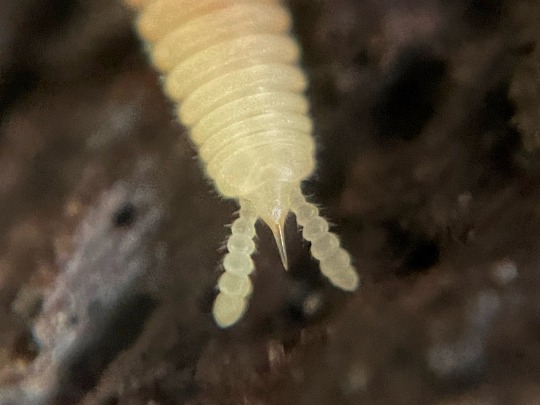
its face manages to be so cute with just two chubby antennae and a piercing beak! these probably feed on fungal hyphae or some sort of biofilms.
some camera photos of the same suctorial friend:

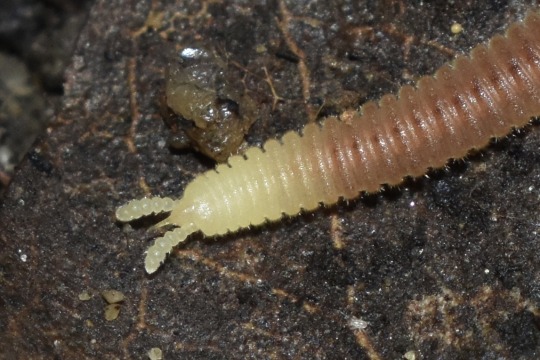
and a larger one, seen at night on a tree trunk:
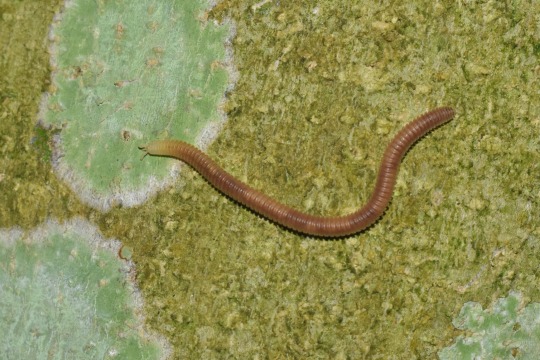
3K notes
·
View notes
Text

Cookiecutter sharks get their name from the cookie-shaped bite marks they leave in prey. The bite marks are caused by the shark suctioning onto their prey with suctorial lips and spinning rapidly to dislodge flesh using their serrated teeth.
#marine animals#marine biology#shark#sharks#fish facts#shark facts#sharkblr#fish#fun facts#science#cookiecutter shark
52 notes
·
View notes
Text
Rhizostomae or Rhizostomeae is an order of jellyfish. Species of this order have neither tentacles nor other structures at the bell's edges. Instead, they have eight highly branched oral arms, along which there are suctorial minimouth orifices. (This is in contrast to other scyphozoans, which have four of these arms.) These oral arms become fused as they approach the central part of the jellyfish. The mouth of the animal is also subdivided into minute pores that are linked to coelenteron.
214 notes
·
View notes
Photo
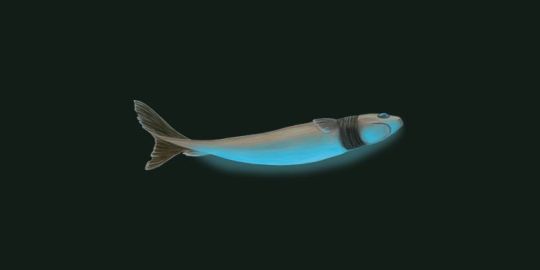

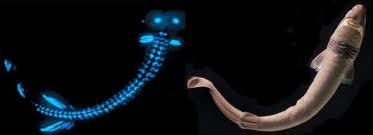

The cookiecutter shark also called the cigar shark, the luminous shark, and the demon whale biter, is a species of small squaliform shark in the family Dalatiidae. This shark occurs in warm, oceanic waters worldwide, particularly near islands, often over 2 miles down. It migrates vertically up to 2 miles every day, approaching the surface at dusk and descending with the dawn. The name "cookiecutter shark" refers to its feeding habit of gouging round plugs out of larger aquatic animals such as marine mammals, cephalopods, boney fish, rays, and other sharks, as if cut out with a cookie cutter. Said cookie cutter marks have also been found on submarines, fishing nets, undersea cables, and even humans. They are also known to eat small prey such as squid, small fish, and crustaceans. They are a social species which is known to travel in schools that communicate with each other by shining there vibrant blue/ green biolumenscent undersides, these concentrations of lights also act to discourage and disorientate larger predators. Females are larger reaching up to 22 inches in length compared to 17 inches for males, both sport long, cylindrical bodies with a short, blunt snout, large eyes, two tiny dorsal fins, and a large caudal fin. They are dark brown, with light-emitting photophores covering its underside except for a dark "collar" around its throat and gill slits. The mouth is short and is surrounded by enlarged, fleshy, suctorial lips. The upper and lower jaws are extremely different; the upper teeth are small, narrow, and upright, tapering to a single, smooth-edged cusp. The lower teeth are also smooth-edged, but much larger, broader, and knife-like, with their bases interlocking to form a single saw-like cutting edge. Like other dogfish sharks, the cookiecutter shark is aplacental viviparous, Mating occurs year round and Females give birth to litters of 6 to 12 pups. Under ideal conditions a cookie cutter shark may live upwards of 25 years.
#cookiecutter#shark#cigar#luminous#demon#whale#bite#biter#tuna#deepsea#deep#sea#fish#pleistocene pride#pleistocene#bioluminescence
16 notes
·
View notes
Text
Rhizostomae or Rhizostomeae is an order of jellyfish. Species of this order have neither tentacles nor other structures at the bell's edges. Instead, they have eight highly branched oral arms, along which there are suctorial minimouth orifices. (This is in contrast to other scyphozoans, which have four of these arms.) These oral arms become fused as they approach the central part of the jellyfish. The mouth of the animal is also subdivided into minute pores that are linked to coelenteron.
2 notes
·
View notes
Text
All the General Character lists
zoloje yay
Urochordata
Exclusively marine and cosmopolitan, found in all seas at all depths.
Mostly sedentary, some free-swimming.
Simple (solitary), aggregated in groups or composite (colonial)
Size (0.25-250mm), shape, and color variable.
Adult body degenerate, sac-like, unsegmented, without paired appendages and usually without tail.
Notochord present only in larval tail, hence "urochordata".
Respiration through test and gill-slits
Mostly hermaphrodite. Fertilization cross and external.
Development indirect including a free-swimming tailed larva with basic chordate characters. Metamorphosis retrogressive.
Asexual reproduction by budding common.
Cephalochordata
Marine, widely distributed in shallow waters
Mostly sedentary and buried with only anterior body end, projecting above bottom sand.
Body small, 5 to 8 cm long, slender, fish-like, metameric and transparent.
Head lacking. Body has trunk and tail.
Paired appendages lacking. Median fins present.
Exoskeleton absent. Epidermis single-layered.
Notochord rod-like, persistent, extending from rostrum to tail, hence the name Cephalochordata.
Sexes separate. Gonads numerous and metamerically repeated. Gonoducts lacking. No asexual reproduction.
Fertilization external in sea water.
Development indirect, including a free-swimming larva.
Cyclostomata
Body elongated, eel-like.
Median fins with cartilaginous fin rays, but no paired appendages. Tail diphycercal.
Skin soft, smooth containing unicellular mucous glands but no scales.
Trunk and tail muscles segmented into myotomes separated by myocommata.
Endoskeleton fibrous and cartilaginous. Notochord persists throughout life. Imperfect neural arches over notochord represent rudimentary vertebrae.
Jaws absent in group Agnatha
Mouth ventral, suctorial and circular, hence "cyclostomata".
Dorsal nerve cord with differentiated brain. 8-10 pairs of cranial nerves.
Sexes separate or united. Gonad single, large, without gonoduct.
Fertilization external. Development direct or with a prolonged larval stage.
Chordata
Aquatic, aerial or terrestrial. All free-living with no fully parasitic forms.
Body small to large, bilaterally symmetrical and metamerically segmented.
A postanal tail usually projects beyond the anus at some stage and may or may not persist in the adult.
Exoskeleton often present; well developed in most vertebrates.
Bodywall triploblastic with 3 germinal layers: ectoderm, mesoderm, and endoderm.
A skeleton rod, the notochord, present at some stage in life.
A cartilaginous or bony, living and jointed endoskeleton present in the majority of members.
Pharyngeal gill slits present at some stage; may or may not be functional.
Digestive system complete with digestive glands.
Sexes separate with rare exceptions.
Pisces
Aquatic, marine, or freshwater, herbivorous or carnivorous, cold-blooded, oviparous or ovoviviparous vertebrates.
Body usually spindle-shaped, streamlines and differentiated into head, trunk and tail. A neck is absent.
Locomotion by paired pectoral and pelvic fins along with median dorsal and caudal, supported by true dermal fin rays. Muscular tail used in propulsion.
Exoskeleton of dermal scales, denticles, or bony plates covering body surface.
Endoskeleton cartilaginous or bony. Jaws are hinged. Notochord more or less replaced by true vertebrae.
Respiration by gills. Gill-slits 5-7 pairs, naked or covered by operculum.
Heart 2 chambered, 1 auricle and 1 ventricle. Venous or single circuit. Sinus venosus and renal and portal systems present.
Kidneys mesonephric. Excretion ureotelic.
Brain with usual 5 parts. 10 pairs of cranial nerves.
Sexes separate. Gonads typically paired. Gonoducts open into cloaca or independently.
Amphibia
Aquatic or semiaquatic (freshwater), air and water breathing, carnivorous, cold-blooded, oviparous, tetrapod vertebrates.
Head distinct, trunk elongated. Neck and tail maybe present or absent.
Limbs usually 2 pairs (tetrapod), some limbless. Toes 4-5 (pentadactyl) or less. Paired fins absent. Median fins, if present, without fin rays.
Skin soft, moist, glandular. Pigment cells (chromatophores) present.
Exoskeleton absent. Digits clawless. Some with concealed dermal scales.
Endoskeleton mostly bony. Notochord does not persist. Skull with 2 occipital condyles.
Respiration by lungs, skin and mouth lining. Larvae with external gills which may persist in some aquatic adults.
Heart 3-chambered, 2 auricles and 1 ventricle. Sinus venosus present. Aortic arches 1-3 pairs. Renal and hepatic portal systems well developed.
Brain poorly developed. Cranial nerves 10 pairs.
Sexes separate. Male without copulatory organ. Gonoducts open into cloaca. Fertilization mostly external. Females mostly oviparous.
Development indirect.
Reptilia
Predominantly terrestrial, creeping or burrowing, mostly carnivorous, air-breathing, cold-blooded, oviparous, and tetrapodal vertebrates.
Body bilaterally symmetrical and divisible into 4 regions: head, neck, trunk, and tail.
Limbs 2 pairs, pentadactyl. Digits provided with horny claws. However, limbs absent in a few lizards and all snakes.
Exoskeleton of horny epidermal scales, shields, plates, and scutes.
Skin dry, cornified and devoid of glands.
Endoskeleton bony. Skull with one occipital condyle (monocondylar). A characteristic t-shaped interclavicle present.
Heart usually 3 chambered/partially 4 chambered, 4 chambered in crocodiles. Sinus venosus reduced. 2 systematic arches present. RBC oval and nucleated. Cold-blooded.
Respiration by lungs throughout life.
Brain with better development of cerebrum than in Amphibia. Cranial nerves 12 pairs.
Sexes separate. male usually with muscular copulatory organ.
Parental care usually absent.
Aves
Feather-clad, air-breathing, warm-blooded, oviparous, bipedal, flying vertebrates.
Limbs are two paired. Forelimbs are modified as wings for flying. Hindlimbs are large and variously adapted for walking, running, scratching, perching, food capture, swimming, or wading.
Pectoral muscles of flight are well developed.
Endoskeleton fully ossified, light but strong and without epiphyes. Long bones pneumatic or hollow and have no marrow. Usually, there is a fusion of bones.
Heart completely 4 chambered. There is neither sinus venosus nor truncus arteriosus. Only right aortic arch persists in adult. Renal portal system vestigial. RBCs nucleated.
Birds are the first vertebrates to have warm blood. Body temp. is regulated.
Respiration by compact, spongy, non-distensible lungs continuous with thin-walled air-sacs.
Brain large but smooth. Cerebrum, cerebellum, and optic loves greatly developed. Cranial nerves 12 pairs.
Sexes separate. Sexual dimorphism often well marked.
Parental care well marked.
Mammalia
Hair-clad, terrestrial, air-breathing, mostly warm-blooded, viviparous, tetrapod vertebrates.
Body distinctly divisible into head, neck, trunk, and tail.
Respiration always by lungs (pulmonary). Glottis protected by a fleshy and cartilaginous epiglottis. Larynx contains vocal cords.
Heart 4 chambered with double circulation. Only the left aortic arch present. Renal portal system absent. RBCs small, circular, and non-nucleated. Body temperature regulated.
Brain highly evolved. Both cerebrum and cerebellum large and convoluted. Optic lobes small and 4 in number. Corpus callosum present connecting both cerebral hemispheres. Cranial nerves 12 pairs.
Sexes separate. Sexual dimorphism generally well marked. Male has an erectile copulatory organ or penis. Testes commonly found in a bag or scrotum outside the abdomen. Eggs are small, with little yolk and no shell.
Fertilization internal, preceded by copulation.
After birth, young nourished by milk secreted from mammary glands of mother.
Parental care well-developed reaching its climax in humans.
Mammals show greatest intelligence among all animals.
1 note
·
View note
Text
LONG POST: (Re)Designing a Solifugid Monster: Step by Step
(Kickstarter crosspost)

Following from my more detailed post about my setting’s human-arthropod hybrids, this was my previous take on the fusion of a human with a Solifugid,or what some people know as a "camel spider." Its design is over sixteen years old now, which I suppose makes it a classic, but all I originally did here was draw a slightly weird camel spider and give it a few humanoid hands. That isn't nearly up to over a decade and a half of my standards evolving, so what we're going to do today is just completely disregard it and reinvent this creature from the ground up, demonstrating every single step I go through to turn a real-world arthropod into a monster design.
FIRST: WHAT ACTUALLY IS EVEN A SOLIFUGID???

(source)
A solifugid is an arachnid sometimes known as a camel spider, sometimes a sun spider, sometimes a "wind scorpion," but isn't really any kind of spider or scorpion. It's actually more related to ticks and mites than anything else!

It's a predator built for extreme speed, both in terms of pursuing and actually eating its prey: not only can it run like lightning, but its chelicerae - the same appendages as a spider's fangs - are built like a pair of gigantic, muscle-packed shears that can shred through a hapless beetle, tarantula or lizard in just seconds.
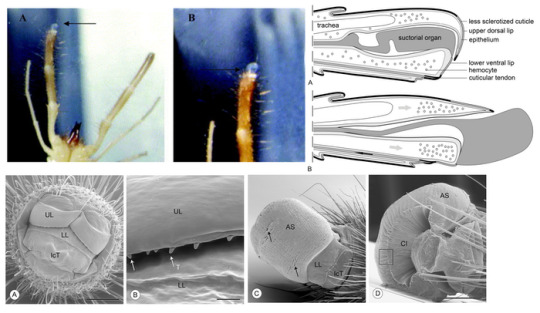
A solifugid also looks at first like it has ten legs, rather than eight, but the frontmost pair of "legs" are actually its highly elongated palps. These are the same appendages as a scorpion's claws, but the solifugid's palps are covered in sensitive hairs that aid in navigation, and they end in retractable, sticky "suctorial organs" that stick firmly to prey like a chameleon's tongue or a gecko's toes, reeling them straight into that terrifying mouth.
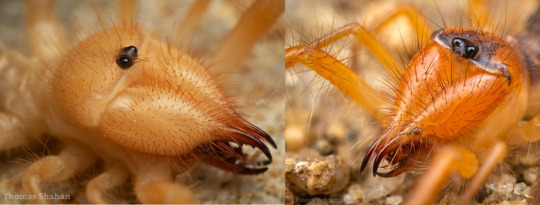
(source)
So the key biological characteristics of a Solifugid are the crushing jaws, impressive running speed, and suction-cup grabbers, all pretty easy and simple to keep in mind, but now what's important to me are its key aesthetic qualities: what do I find most interesting about the way this creature actually looks?
This will be different for everybody, but personally I'm charmed by the animal's big, awkward looking head, the fact that its face is mostly those huge, bulbous mouthparts, and the two absurdly tiny, beady eyes that give an otherwise lethal creature an adorable, timid looking visual personality. Solifugids are as a matter of fact VERY skittish animals, prone to fleeing at the first sign of a larger threat. With all that in mind:
FACE DESIGN
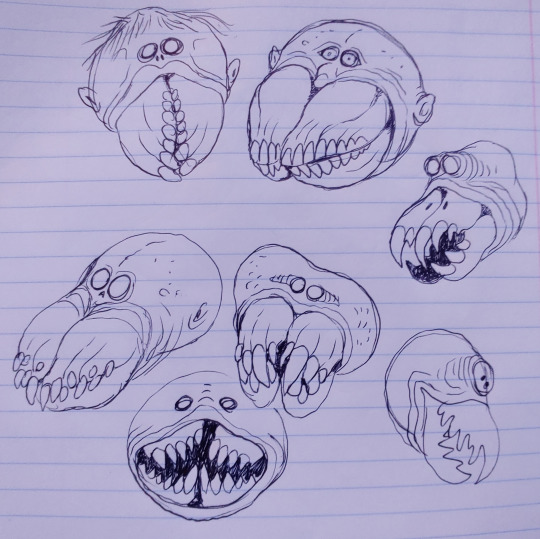
This monster is supposed to be half human, so the first thing I sketch is how I think the head of a Solifugid would look made entirely of human facial features. I already know that isn't what I'm going for, and the horrible Garbage Pail Kid that results is too "creepy," completely losing the original animal's cute streak. Making the chelicerae from teeth and gums, however, was kind of always a given, so I draw some other takes on that, and I like some things about them but not enough that any really stick with me.

So I look at the real creature again, and I actually notice for the first time in my life that when seen from above, the eyes almost protrude beyond the "lip" or "rim" where the chelicerae emerge, and I realize that's been a key part of that cuteness I keep seeing. I just sort of instantly decide to capture this by pulling the "lip" of my monster version up behind its eyes, and it works perfectly! Its eyes now look cute to me! The furrowed rim even gives it a "worried" sort of look, like it's actually cowering within its own jaws. I feel like this is a perfect place to leave the head design just for now, so then we can move on to:
BODY DESIGN
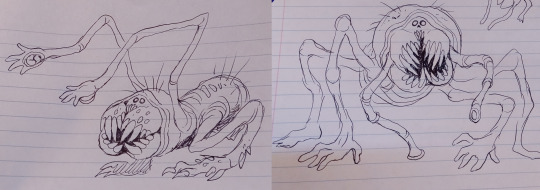
One way I bring out the human aspect in these mashups is by sticking to just four appendages. An obvious route is to keep the sticky grabbers as its arms and hands. This leaves it only two legs, but that just communicates the running speed better than I hoped.
If you remember from earlier though, the suction palps of a camel spider AREN'T legs, but mouth parts attached to the head, and that might be an interesting aspect to consider. Maybe they could even be made of squishy gum flesh, more tentacle-like and emerge from the corners of the monster's jaws?
This would free it up to have four actual legs, which could give it a more arachnid-like stance again...but I find that kind of underwhelming. I like the two-legged runner idea.
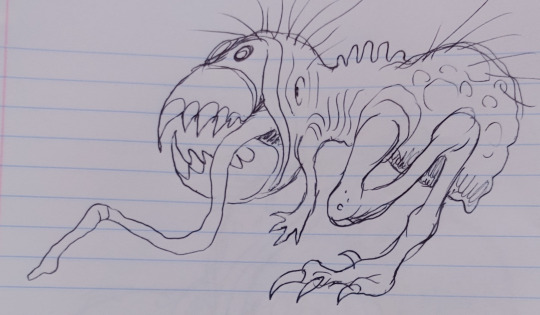
A possible solution comes straight from another kind of two-legged predator with a big, giant head and jaws: if we shrink the forelegs down like ancient Carnosauria, we can keep the grabbers as mouthparts, keep it a four-limbed metahuman, and keep it running on just two legs.

I do a few more sketches of this kind of design, and I like something about all of them, but I feel like the head concept still isn't finished. On its own, it still looks just a little too much like the face of "only" a big bug. Where can something "more human" go without interrupting that "perfect" (to me) arrangement of the jaws and eyes? Pretty much only on the rest of the big, round head.
REVISITING THE FACE
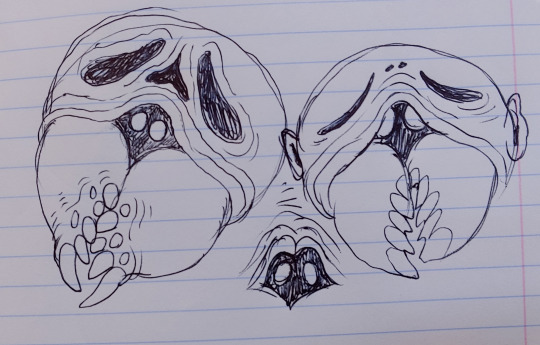
After some more miscellaneous doodling I go back to these face sketches, adding pits that resemble a nose hole and eye sockets. At first I think of them as bony, like a skull, but if they're soft and fleshy, the face takes on a more disturbing monster quality that in my opinion still doesn't subtract from the parts I found endearing.

Sketching more heads along these lines, I also consider treating the chelicerae as their own vertebrate skulls, and really want to see how that looks on a completed monster.
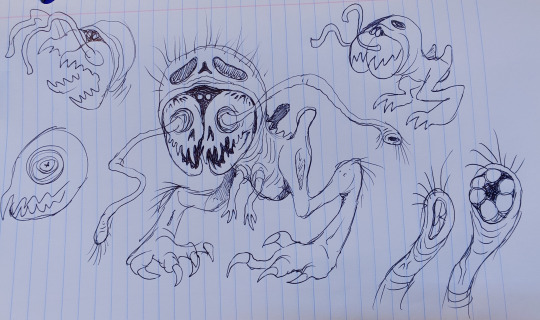
So in the next full body sketch, I drop the abdomen and just make the legs a lot larger to balance out the head. Now that the chelicerae are "skulls" with their own "eye sockets," I also try out how it would look if the palps actually emerge from those. It's kind of a neat effect, BUT, now I feel like the design has TOO MANY "weird" factors that just muddle it up.
So I go back through all of these sketches, I pick out the aspects I really find the most appealing - my favorite stance, my favorite jaws, my favorite proportions - and I try to bring those all together for hopefully one last try:
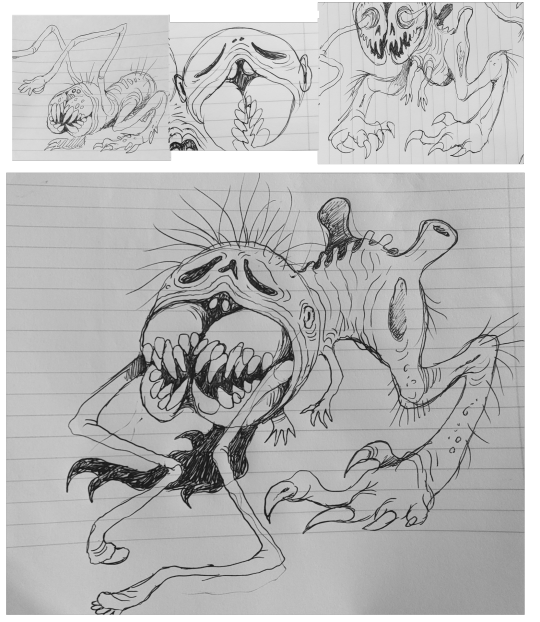
......And everyone will have differing opinions, but for me, this is finally just right! This is the design that reminds me of the real animal in every way I want it to, while looking as much like a freaky, warped humanoid as I also want it to. It looks dangerous and unnatural but it also looks a little shy and uncertain; a chomping, gnashing, bounding, horrible thing to its prey but possibly a big soft coward on the inside. This will most likely be the sketch on which I base its full-color artwork some time in the future, so it now goes in a folder where I keep every satisfactory concept design until they're ready to clean up.
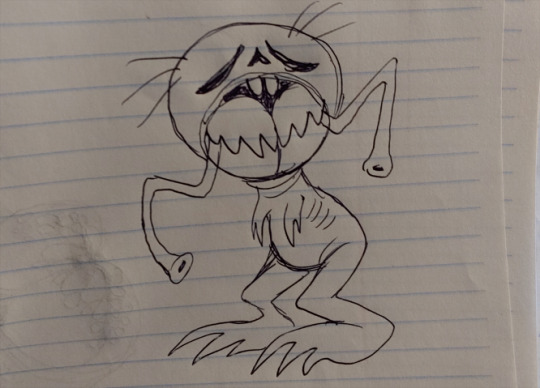
And as a final, extra test of this monster's look, I scribble an extra-simplified cartoon version that demonstrates an entirely different pose. Everything I liked about the design is still evident here, and I even like how its eyes can also be interpreted as buck teeth in its "other" face, which I hadn't considered until now. If you can strip all the fine details from a design and it still doesn’t look like any other you can recall, you should probably keep it!
There are some designs I settle on quite a bit faster, even some that I like from the very first sketch, while other designs have gone through several times as many attempts as this one, but there’s always a rationalization I put into every detail, considering both how the creature “works” and the kind of character I want it to convey.
#mortasheen#art#biology#animals#arachnids#camel spider#solifugid#bugs#arthropods#monsters#creature design
756 notes
·
View notes
Text
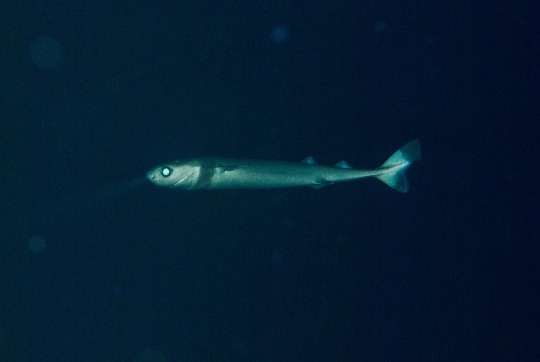
The Cookie Cutter Shark
***
The cookiecutter shark, also called the cigar shark, is a species of small squaliform shark in the family Dalatiidae. This shark occurs in warm, oceanic waters worldwide, particularly near islands, and has been recorded as deep as 3.7 km.
• It’s had three scientific names: When the shark was discovered in 1824, it was named Tristius brasiliensis, followed by Scymnus brasiliensis, and, finally, its current name, Isistius brasiliensis. The genus name refers to Isis, the Egyptian god of light; the species name refers to one place it's found, off the coast of Brazil.
• Its common name comes from the cookie cutter-like wounds it leaves in its prey. Its shape has also led some to call it the cigar shark. If you prefer to refer to it in another language, though, the Florida Museum of Natural History has you covered: almindelig cookiecutterhaj (Danish), cação luminoso (Portuguese), kleiner leuchthai (German), koekjessnijder (Dutch), squalelet féroce (French), and tiburón cigarro (Spanish) are just a few you could use.
• The name cookiecutter is somewhat misleading—the shark’s bites are actually conical. (Ed Yong at National Geographic suggests that “ice cream scoop shark” might be more accurate.)
• The entire underside of the cookiecutter glows thanks to light-emitting organs in its skin called photophores. Some scientists think the sharks use this bioluminescence to blend in with the moonlight, while a dark, unlit collar around its throat, which resembles a fish, draws its prey up from the bottom. (The sharks are also capable of using the organs to flash like a strobe light.) However, George Burgess, a shark expert at the Florida Museum of Natural History, told Wired that the collar does, in fact, glow, and “suggests that by flashing, the band may help draw would-be predators to the 'business end' of the shark.” Regardless of what’s luring the prey, once it’s close enough, the cookiecutter does a bait and switch and has a meal itself.
• The fish lives at depths of 3200 feet during the day, but migrates vertically at night to feed.
• Speaking of eating: To feed, the shark uses its suctorial lips to suction itself onto its prey. Once it’s attached, the cookiecutter spins its body, using the row of serrated teeth on its lower jaw to remove a plug of flesh—leaving behind a crater-like wound that is 2 inches across and 2.5 inches deep—and dinner is served.
• The sharks typically feed on animals much larger than them, including tuna, stingrays, other sharks (even great whites!), seals, whales, dolphins, and more.
• They’ve even bitten humans. There have been a couple of cases where the sharks have fed on bodies in the water, and one long distance swimmer, Mike Spaulding, was bitten by a cookiecutter while doing a night swim off the coast of Hawaii. Spaulding later described the circumstances behind the incident to Deep Sea News:
I was swimming along in perfect conditions. The wind kicked up a little and I was hoping that it was a local condition that would disappear. We were on 30 min[ute] feeding schedule. At 8:15 I was trailing the boat by about 80 to 100 yards. The boat captain liked to run ahead and then go out of gear and wait for me to catch up. On the previous feeding stop he complained about not being able to see the Kayak and requested we turn on our emergency light so he could see us better. He also turned on his cabin lights at the same time. Fifteen minutes after we turned on the lights and I had my feeding I started to feel squid bumping into me. I assumed they were squid as they felt soft. I did not like this at all ... After the 4th bump I felt a sharp prick just to the left of my sternum. It was excruciating and I gave a yelp. As soon as that happened I knew I had to get out of the water and the swim was over. I reached the front of the kayak and turned off the light and started climbing into a one person kayak. As I was about to push onto the kayak I felt a hit on my left calf. I ran my finger down my leg and felt a 2.5” by ¾ inch hole where I had been hit. … The lights attracted squid with in turn created a food chain which the cookie cutter shark was a part of.
Still, despite what Shark Night 3D would have had you believe, they’re not a danger to us.
• The shark loses its bottom row of triangular teeth—25 to 31 of them—as a unit, then ingests them, probably for calcium. Cookiecutters also have 30 to 37 tiny teeth on the top jaw.
• The shark was discovered in the 1800s, but no one knew it was responsible for the marks on other sharks until the 1970s. According to Yong, “The first breakthrough came in 1963, when a man called Donald Strasburg noticed that the cookie-cutter shark would shed its saw-like lower teeth as a single unit. … In 1971, Everet Jones discovered small conical plugs of flesh in the stomachs of these sharks. He also noticed that their mobile tongues and large lips allow them to form a vacuum on a smooth surface. It became clear that this tiny animal was wounding some of the ocean’s mightiest residents.”
• Some inanimate objects also have something to fear from cookiecutter attacks: The shark posed a threat to nuclear submarines in the 1970s. Cookiecutters took chunks out of the neoprene-covered sonar domes of several American subs, which caused the sound-transmitting oil to leak and blinded the vehicles. To solve the problem, the domes were covered with fiberglass. Telecommunications and oceanographic research equipment have also been damaged by cookiecutters.
• The shark is small: Males grow to a maximum of 16.5 inches, while females grow to 22 inches.
• Cookiecutters give birth to live young that develop inside egg sacs in the shark’s uterus; the mother gives birth shortly after the baby cookiecutters hatch out of the egg cases.
• Reportedly, a shark's photophores can emit a glow up to three hours after it dies. Creepy!
***
@sharkdefenderactivist
#my sharks#hammerhead shark#great white shark#cookiecutter shark#facts about sharks#shark facts#shark defender#sharkbait#swimming with sharks#shark talks#shark lover#shark rights#sharks
59 notes
·
View notes
Photo





youtube
Pycnogonids are deep-sea animals related to the spiders we see on land, so they are often called “sea spiders.” They are fairly common in tide pools, but these intertidal species are typically small and hard to see. In contrast, deep-sea pycnogonids can have long legs that grow to over 50 cm (20 inches) across!
At least two species of the Colossendeis group have been observed by MBARI remotely operated vehicles deep in Monterey Canyon. These spiders are quite mobile and can walk or swim using their eight legs. Pycnogonids are “suctorial” predators—most species feed by sucking the bodily fluids from other marine animals. They feed primarily on anemones, such as the pom-pom anemone, Liponema sp.
796 notes
·
View notes
Photo



The Cookie-Cutter Shark
This shark gets its name from the distinct bite mark it leaves on its prey. Marks made by cookie-cutter sharks have been found on a wide variety of marine mammals and fishes, as well as on submarines, undersea cables, and even human bodies.
Cookie-cutter sharks have adaptations for hovering in the water column and likely rely on stealth and subterfuge to capture more active prey. Its dark collar seems to mimic the silhouette of a small fish, while the rest of its body blends into the down-welling light via its ventral photophores. When a would-be predator approaches the lure, the shark attaches itself using its suctorial lips and specialized pharynx and neatly excises a chunk of flesh using its bandsaw-like set of lower teeth.
This species has been known to travel in schools.
WIKI
1K notes
·
View notes
Photo

Sea Spiders are not related to land spiders, as they are an entirely separate class of animals, known as pycnogonids.
Pycnogonids are "suctorial" predators—most species feed by sucking the bodily fluids from other marine animals.
Deep-sea pycnogonids can grow to over 50 centimeters (20 inches) across, and spend much of their time on the open seafloor. This deep-sea pycnogonid was photographed 2895 meters deep, hunched over a pom-pom anemone, with its proboscis inserted into one of the anemone's tentacles.
Apparently, large anemones can survive numerous such attacks, providing a "renewable resource" for nearby pycnogonids.
via: Monterey Bay Aquarium Research Institute (MBARI)
31 notes
·
View notes
Text

The Greenland shark’s mouth is very similar to that of the cookiecutter; both have suctorial lips, grasping teeth, and cutting teeth.
170 notes
·
View notes
Text
"BTC/USD and The Remora Theory 1" by trader Oboogie — published June 04, 2018 — TradingView
New Post has been published on https://cryptnus.com/2018/06/btc-usd-and-the-remora-theory-1-by-trader-oboogie-published-june-04-2018-tradingview/
"BTC/USD and The Remora Theory 1" by trader Oboogie — published June 04, 2018 — TradingView
Monday Monday, so good to me … Monday morning it was I hoped it will be…
Thinking about this past weekend price movement and reading most of the analysis that mention the undoubtful whale’s presence in the crypto markets, my intention here is to try to develop a ‘theory’ that inquiries the high volatility in the bitcoin market and the presence of whales and other players in the market. I mean, there must be more players than just buyers and sellers, or bulls and bears. The trading market just as life itself, isn’t binary. If you think it is, try looking at things thru a kaleidoscope.
This is the ‘Remoras Theory’ part one.
Looking at the four hours chart, btc has been moving between the 100-MA and 50-MA. It isn’t weird that the price bounced from 7.4k to 7.7k and then dropped from 7.7k to 7.5. But the way it did it, just like many times before, it’s, to say the least, rare. If there’s whales in the market looking for leveraged traders to liquidate, there must be remoras too.
Taking the Merriam-Webster dictionary’s definition, a remora is “any of a family (Echeneidae) of marine bony fishes that have the anterior dorsal fin modified into a suctorial disk on the head by means of which they adhere especially to other fishes”. In other words, “remoras (also called suckerfish) literally stick to the sharks’ skin and when a bigger fish attacks and eats prey, the remora will detach itself and feast on the remains once its host is done” (National Geographic, 11 Aug. 2017). I will get back later to this quote, to explore a trading strategy based on this mother nature’s behavior.
Having said that, this morning in less than five minutes the most important crypto-currency dropped almost what had gained in two or three days. I’m not judging whether that’s normal or not -I guess it is-, my point is that the whales ate the remoras right away. Maybe because leveraged traders are naive or rookies, but the fact is that whales ate bullish and bearish remoras indistinguishably, whether because they were confuse or unaware of the whale’s way of life. All in all, that seems to be a constant behavior in the market, either a bullish or a bearish market, and we could take some tips form it.
First, there are more than two players in the market.
Second, Whales eat remoras all the time with or without subtle manners.
Third, remoras get confused and panic too often.
Fourth, may be I’m too stoned and I will developing this Remoras Theory, reading and mixing TA and biology together.
Peace!
0 notes
Text


Beetles are generally characterized by a particularly hard exoskeleton and hard forewings (elytra) not usable for flying. Almost all beetles have mandibles that move in a horizontal plane. The mouthparts are rarely suctorial, though they are sometimes reduced; the maxillae always bear palps. The antennae usually have 11 or fewer segments, except in some groups like the Cerambycidae (longhorn beetles) and the Rhipiceridae (cicada parasite beetles). The coxae of the legs are usually located recessed within a coxal cavity. The genitalic structures are telescoped into the last abdominal segment in all extant beetles. Beetle larvae can often be confused with those of other endopterygote groups.[44] The beetle's exoskeleton is made up of numerous plates, called sclerites, separated by thin sutures. This design provides armored defenses while maintaining flexibility. The general anatomy of a beetle is quite uniform, although specific organs and appendages vary greatly in appearance and function between the many families in the order. Like all insects, beetles' bodies are divided into three sections: the head, the thorax, and the abdomen
0 notes